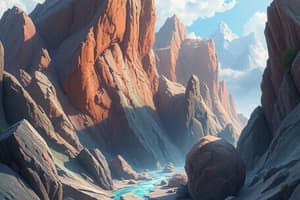Podcast
Questions and Answers
Which of these environments is characterized by wet, spongy soil?
Which of these environments is characterized by wet, spongy soil?
- River beds
- Swamps (correct)
- Deserts
- Volcanic regions
What type of rock is formed from the cementation of sand and gravel?
What type of rock is formed from the cementation of sand and gravel?
- Conglomerate (correct)
- Marble
- Shale
- Granite
Which rock type forms when clay undergoes lithification?
Which rock type forms when clay undergoes lithification?
- Limestone
- Quartzite
- Coal
- Shale (correct)
Which star classification best describes our sun?
Which star classification best describes our sun?
Which geological period is not part of the Mesozoic era?
Which geological period is not part of the Mesozoic era?
From which location did the ice sheet that covered northeastern United States originate?
From which location did the ice sheet that covered northeastern United States originate?
What type of volcano is characterized by being steep-sided and composed of lava flows and pyroclastic material?
What type of volcano is characterized by being steep-sided and composed of lava flows and pyroclastic material?
Which rock family does the solidified lava of a volcano belong to?
Which rock family does the solidified lava of a volcano belong to?
What is a dome-shaped intrusion called in geological studies?
What is a dome-shaped intrusion called in geological studies?
What geological feature is Shiprock in New Mexico classified as?
What geological feature is Shiprock in New Mexico classified as?
Why does Iceland experience significant volcanic activity?
Why does Iceland experience significant volcanic activity?
Which rock type is most resistant to both chemical and mechanical weathering?
Which rock type is most resistant to both chemical and mechanical weathering?
What is the term for dry stream channels with nearly vertical walls and flat bottoms characteristic of semi-arid regions?
What is the term for dry stream channels with nearly vertical walls and flat bottoms characteristic of semi-arid regions?
What percentage of the Earth's water is fresh water?
What percentage of the Earth's water is fresh water?
What is the deep, least productive part of a lake called?
What is the deep, least productive part of a lake called?
Which factor does NOT affect sea level change?
Which factor does NOT affect sea level change?
If all the Earth's ice melted, what would be the approximate increase in sea level?
If all the Earth's ice melted, what would be the approximate increase in sea level?
What is the term for the curved body of water formed when a meandering river reshapes and cuts off one of its bends?
What is the term for the curved body of water formed when a meandering river reshapes and cuts off one of its bends?
The chemical union of iron, oxygen, and water forms which mineral?
The chemical union of iron, oxygen, and water forms which mineral?
What is the term that describes different crystalline modifications of the same chemical substance?
What is the term that describes different crystalline modifications of the same chemical substance?
What percentage of the energy used in the United States is provided by hydroelectric power?
What percentage of the energy used in the United States is provided by hydroelectric power?
Which of the following energy sources does NOT originally come from the Sun?
Which of the following energy sources does NOT originally come from the Sun?
What is the name of the atmosphere layer of upwardly diminishing temperature situated above the stratosphere?
What is the name of the atmosphere layer of upwardly diminishing temperature situated above the stratosphere?
What percentage of the Earth's atmosphere does oxygen (O2) comprise?
What percentage of the Earth's atmosphere does oxygen (O2) comprise?
Which type of rays are responsible for tanning the skin?
Which type of rays are responsible for tanning the skin?
What is the relative humidity when the absolute humidity is 3 grams per cubic meter and the air has a capacity of 12 grams per cubic meter?
What is the relative humidity when the absolute humidity is 3 grams per cubic meter and the air has a capacity of 12 grams per cubic meter?
Which two gases found in the atmosphere do NOT significantly contribute to solar heating?
Which two gases found in the atmosphere do NOT significantly contribute to solar heating?
Global climate change is predominantly attributed to the increase in what two gases due to human activities?
Global climate change is predominantly attributed to the increase in what two gases due to human activities?
What is the term used to measure the intensity of solar radiation and is equivalent to one gram calorie per square centimeter per minute?
What is the term used to measure the intensity of solar radiation and is equivalent to one gram calorie per square centimeter per minute?
What gas makes up the majority of the Earth's atmosphere?
What gas makes up the majority of the Earth's atmosphere?
Flashcards
Composite Cone Volcano
Composite Cone Volcano
A volcano formed from alternating layers of lava flows and pyroclastic material, resulting in a tall, steep-sided structure.
Laccolith
Laccolith
A dome-shaped intrusion of magma that forces its way into surrounding rock layers, creating a bulge on the surface.
Igneous Rock
Igneous Rock
The solidified lava of a volcano belongs to this rock family. These rocks form when molten rock cools and solidifies.
Exfoliation
Exfoliation
Signup and view all the flashcards
Quartzite
Quartzite
Signup and view all the flashcards
Geosphere
Geosphere
Signup and view all the flashcards
Mid-Ocean Rift
Mid-Ocean Rift
Signup and view all the flashcards
Alluvium
Alluvium
Signup and view all the flashcards
Arroyo
Arroyo
Signup and view all the flashcards
Freshwater percentage
Freshwater percentage
Signup and view all the flashcards
Profundal Zone
Profundal Zone
Signup and view all the flashcards
Sea level change
Sea level change
Signup and view all the flashcards
Sea level rise
Sea level rise
Signup and view all the flashcards
Oxbow lake
Oxbow lake
Signup and view all the flashcards
Limonite
Limonite
Signup and view all the flashcards
What is the lithosphere?
What is the lithosphere?
Signup and view all the flashcards
Polymorphism
Polymorphism
Signup and view all the flashcards
Which energy source doesn't come from the Sun?
Which energy source doesn't come from the Sun?
Signup and view all the flashcards
What is the mesosphere?
What is the mesosphere?
Signup and view all the flashcards
Hydroelectric power's share
Hydroelectric power's share
Signup and view all the flashcards
What is a Langley?
What is a Langley?
Signup and view all the flashcards
What percentage of our atmosphere is oxygen?
What percentage of our atmosphere is oxygen?
Signup and view all the flashcards
What gas is the most abundant in our atmosphere?
What gas is the most abundant in our atmosphere?
Signup and view all the flashcards
What kind of rays cause tanning?
What kind of rays cause tanning?
Signup and view all the flashcards
What is the relative humidity if the absolute humidity is 3 g/m³ and the capacity is 12 g/m³?
What is the relative humidity if the absolute humidity is 3 g/m³ and the capacity is 12 g/m³?
Signup and view all the flashcards
Which two gases don't absorb much solar heat?
Which two gases don't absorb much solar heat?
Signup and view all the flashcards
What type of rock is conglomerate?
What type of rock is conglomerate?
Signup and view all the flashcards
What is shale made from?
What is shale made from?
Signup and view all the flashcards
What type of star is our Sun?
What type of star is our Sun?
Signup and view all the flashcards
Why are fossils rarely found in granite?
Why are fossils rarely found in granite?
Signup and view all the flashcards
Which map projection is used for navigation?
Which map projection is used for navigation?
Signup and view all the flashcards
What is the main component found in the B-horizon of a pedalfer soil?
What is the main component found in the B-horizon of a pedalfer soil?
Signup and view all the flashcards
Where are Pedocal soils commonly found?
Where are Pedocal soils commonly found?
Signup and view all the flashcards
What is the main component of high-quality crop soil?
What is the main component of high-quality crop soil?
Signup and view all the flashcards
What is the name of the aquifer responsible for artesian wells in the Great Plains?
What is the name of the aquifer responsible for artesian wells in the Great Plains?
Signup and view all the flashcards
What type of rock serves as the main aquifer in Florida?
What type of rock serves as the main aquifer in Florida?
Signup and view all the flashcards
What is the process called where sand grains are transported by wind in jumps and bounces?
What is the process called where sand grains are transported by wind in jumps and bounces?
Signup and view all the flashcards
What is the surface layer of a desert pavement primarily composed of?
What is the surface layer of a desert pavement primarily composed of?
Signup and view all the flashcards
What type of dune has a crescent shape?
What type of dune has a crescent shape?
Signup and view all the flashcards
What weather condition does NOT result from a low-level temperature inversion?
What weather condition does NOT result from a low-level temperature inversion?
Signup and view all the flashcards
Study Notes
Science Bowl Study Notes
- ERSC-91, 92, 93: Various multiple-choice and short-answer questions covering several Earth Science topics. Questions relate to specific minerals, rocks, processes, and geographic features. Information includes locations, compositions, classifications, formation processes, and more.
- Minerals: Specific questions on various minerals, including their properties (e.g., hardness, cleavage, streak), uses, and chemical formulas. Examples like quartz, calcite, feldspar, hematite, cinnabar, and others are included.
- Igneous Rocks: Formation, composition, and classification of igneous rocks are discussed. Volcanoes, lava, magma, and volcanic features (e.g., cinder cones, shield volcanoes, explosive eruptions) are included.
- Sedimentary Rocks: Formation, composition and classification of sedimentary rocks. Descriptions of various types (e.g., sandstone, conglomerate, shale, limestone) along with processes like weathering, erosion, and deposition are covered.
- Metamorphic Rocks: Formation, composition, and classification of metamorphic rocks. Descriptions of types, such as marble and slate, along with their formation processes through heat and pressure.
- Earthquakes: Details on earthquake-related terms like the Moho, focus, and the epicenter. Questions include the Richter scale and different types of faults.
- Weathering: Mechanisms of chemical and mechanical weathering are explored.
- Landforms: Features like mountains, plateaus, valleys, and canyons are addressed. Emphasis on glacial formations like moraines, U-shaped valleys, and others.
- Atmospheric Phenomena: Various atmospheric conditions, like the jet stream, wind patterns, and the effects of the Coriolis effect.
- Geological Time: Different geologic periods, eras, and their sequence. Information includes fossils, and other geological events.
- Global Climate Change: Processes (e.g., deforestation, fossil fuel combustion) contributing to climate change are discussed.
- Earth Surface Features: Details on surface features that relate to erosion, uplift, and tectonic plate movements.
- Hydrology: Terms and concepts related to water movement, including rivers (e.g., yazoo streams, oxbow lakes), and rainfall.
- Other topics: Information on various geological processes, elements, concepts and geographic locations across different continents and geological areas.
Additional Note
- Study the provided questions and answers to gain a deeper understanding of the specific concepts addressed. Pay attention to the different ways questions were asked about similar topics.
Studying That Suits You
Use AI to generate personalized quizzes and flashcards to suit your learning preferences.




